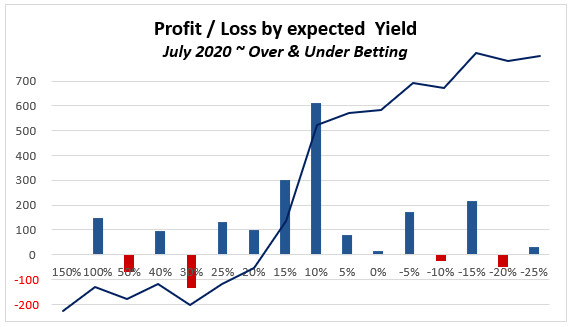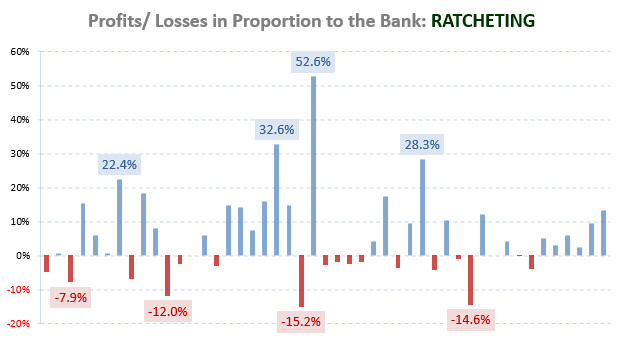
Interpreting the Goal Distribution Graphs
 Image: Vinicius Tupinamba (Shutterstock)
Image: Vinicius Tupinamba (Shutterstock)As you can see, the goal distribution graphs look fairly similar for all leagues: the curves rise steeply up to the threshold of two goals per game, peak around this figure, and then begin slowly dropping.
This spread is called Poisson Distribution, which in maths also determines things like radioactive decay (and the lingering strength of garlic breath, no doubt!).
A radioactive particle disintegrates over time and the rate of decay can be calculated using the Poisson Distribution method.
Such a distribution always begins at a known value, runs quickly up to a maximum, and then slowly drops as it approaches larger values.
The ‘peak’ threshold in football games to look at when betting is the average number of goals per game, analysed as we have here, over five years.
Depending upon the league in question, the middle of the distribution always lies somewhere between two and three goals (hence the popularity of ‘Over & Under 2.5 Goals’ markets with both bookmakers and betting exchanges).
In our examples, the average numbers of goals per game are: EPL: 2.6; Ligue 1: 2.3; Bundesliga 1: 2.8; Eredivisie: 3.0.
Mathematically speaking, the area in each graph between the horizontal axis (the ‘X’ axis) and the Poisson lines themselves always equates to ‘one’ purely because the probability that one of the results will happen is always 100% (i.e. it is 100% certain that the game must contain either zero, one, two, three goals, etc.).
Using the concept of ‘one’, exact probabilities can be calculated by using the “Euler’s Number” together with “K!” (faculty), and thus odds can be developed.
But this is a higher level of mathematics than you need to know at this stage.
There is a very descriptive and well explained article on Poisson Distribution (together with all the formulae) in the article What have a football team and a radioactive source in common? (www.weltderphysik.de) – It’s written in German, but easily translated using Babel Fish or Google Translate.
Under the Microscope:
Now, a closer look at our graphs above reveals the following trends:-
- Bundesliga 1 exhibits the most regular goal distribution (all five seasons’ curves follow similar paths). This is despite having fewer games per season (306) than both the EPL and Ligue 1 (380 games per season). This is paradoxical because a more even distribution should be expected from a larger sample size.
- There is a fairly consistent number of Dutch games finishing 0-0 each season.
- Most of the French top-flight fixtures finish with less than six goals (i.e. the ‘Under 5.5 Goals’ market).
- Within the two goal threshold (i.e. the ‘Under/Over 2.5 Goals’ market) all leagues show larger variances than in any of the other goal event categories.
Nota Bene: Spend a little time comparing the graphs and see what other discoveries you can make!
Looking at Goal Distributions from a ‘Deviation’ Perspective
In order for you to understand the term ‘Relative Deviation’ it is necessary first to grasp the concept of ‘Absolute Deviation’.
For example, analysing our data set to quantify the average number of times that two-goal game events occur in a season is fairly easy.
This is just a matter of adding up all of the two-goal game events over ‘X’ number of seasons and then dividing by ‘X’ to reach the average per season (where ‘X’ is the total number of seasons represented in the data set).
 Image: Andresr (Shutterstock)
Image: Andresr (Shutterstock)Absolute deviation is the difference (or ‘deviation’) each season’s data set shows from the average for that whole data set.
Effectively, it is a simple way of comparing ‘apples’ (the average) with ‘pears’ (the deviation).
Relative deviation takes this idea one stage further and allows the comparison of different events with different results within the same data set.
It is difficult to envisage a direct comparison between, for example, two-goal events and three-goal events over a period of five years if they both have different frequencies and therefore different averages.
Relative deviation analysis allows an ‘apples’ with ‘apples’ comparison of this information to be made.
Relative Deviation Examples:
- Say a season contains 100 matches and over five seasons the average containing over 2.5 goals is 50. One of those seasons contains 52 matches over 2.5 goals.The absolute deviation for that season is 2% (i.e. 52% is 2% different from the average), whilst the relative deviation is 4% (52 divided by 50 and then shown as a percentage).
- Say the average number of games per season containing over 5.5 goals is only five. The same season we are analysing contains seven such matches.Again, the absolute deviation is 2%, whereas the relative deviation is much larger at 40%. This means that the ‘error’ or deviation relative to the norm in this season was far greater for over 5.5 goals than for over 2.5 goals.
Thus, just tiny fluctuations in events with smaller average expectations have a greater tendency to ‘upset the apple cart’ when it comes to betting.







Thank you for sharing this article. So in an attempt to be more practical. Assuming we detected that under 1,5 goals has an average of 9% success with a deviation of +-1,5%. That would mean the range should vary from 7,5% to 10,5%. How could we build our portfolio? Take the worse scenario of 7,5% which means we need a minimum odds of 1/0,075 equals 13,33. But who can guarantee that we will get these odds from the bookies?
Hi betakos, there is no “guarantee” that you will get your desired odds from the bookies. If you use exchanges such as Smarkets then, of course, you can “ask” for your desired odds and hope that somebody matches your bet.
Do you know my course Fundamentals of Sports Betting – Over/Under X Goals? In part 2 I explain in great length how to utilise the knowledge of odds calculation, and with the cluster tables which come with the course I provide readers with a powerful portfolio betting tool for value betting.